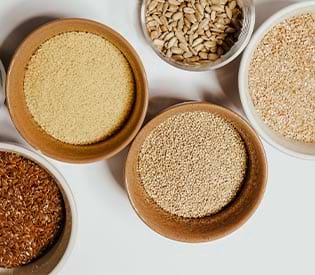Coltsfoot Leaf Powder
📦🚚 Fast & Free shipping on all orders
What is Coltsfoot Leaf Powder?
There is a large list of herbs that are often called weeds, and coltsfoot (Tussilago farfara) is one of them. When it first peeks out of the ground in the spring, it is not uncommon to see it flourishing in the wild. Coltsfoot is a common weed that is often confused with dandelion due to its brilliant yellow flowers and leaves that are shaped like a horse's hoof, thus the name. The leaves are the most often picked component, although the buds and flowers before they bloom are also useful. Coltsfoot is unusual in that it produces flowers before its leaves appear. This distinguishing feature separates Filius ante patrem from dandelion, a common weed, and is responsible for the plant's Latin moniker, Filius ante patrem ('son before father'). Western herbalists and practitioners of traditional Chinese medicine have both found several uses for coltsfoot. It has a long history of usage in the treatment of skin irritation and problems, as well as respiratory conditions including coughs, asthma, and bronchitis.
The Latin term tussilago, which means "cough" and "depart," appropriately names the disease. According to legend, coltsfoot was often burned during magical ceremonies, such as those intended to contact a deceased loved one. Using a special chant and the leaves, people in England could see into the future.
How do I use Coltsfoot Leaf Powder?
Coltsfoot leaves possess expectorant, tonic, and demulcent qualities. Historically, people have smoked the leaves to alleviate congestion. A teacupful of a decoction of 1 ounce of leaves in 1 quart of water, flavored with honey and reduced to 1 pint, can be consumed to treat asthma and colds.
Coltsfoot Leaf Powder benefits:
Coltsfoot, according to scientific research, has a high concentration of mucilage. Coating the throat with this material helps calm breathing. Asthma, sore throat, wheezing, bronchitis, and laryngitis are among the conditions that may benefit from using this herb. The ancient herbalists Dioscorides and Phiny suggested smoking the plant to soothe the throat. Even though it's unlikely that smoking Coltsfoot may accelerate the healing process for a sore throat, it's sometimes recommended as a healthier alternative to tobacco.
Coltsfoot has been administered topically to the skin for other reasons as well. Coltsfoot flowers were originally used as a poultice for various skin conditions, including inflammation, dermatitis, and stinging.
◉ May reduce inflammation: Asthma and gout are two examples of inflammatory illnesses that coltsfoot is used to treat. Gout is a kind of arthritis that causes swelling and joint discomfort. Coltsfoot may contain anti-inflammatory qualities, yet data on these illnesses is sparse. A disease called drug-induced colitis causes inflammation in the intestines. Researchers found that an active ingredient in coltsfoot lowers many markers of inflammation in mice with this disease.
◉ Could benefit brain health: Coltsfoot has shown promise as a possible brain health protector in studies. One in vitro investigation found that coltsfoot extract protected nerve cells from injury and actively countered free radicals; these substances lead to the development of chronic illness. Coltsfoot extract was also shown to protect nerve cells, prevent brain tissue loss, and lower inflammation in animal research.
◉ May treat chronic cough: Coltsfoot is a common herbal treatment for respiratory illnesses, including bronchitis, asthma, and whooping cough, in alternative medicine. Coltsfoot has shown promise in animal studies for treating persistent coughs due to these illnesses. In research on mice, a combination of coltsfoot chemicals was shown to decrease cough frequency by 62%, increase sputum output, and decrease inflammation. Extracts from the flower bud of this plant were given orally to mice, and the results showed a reduction in coughing and an increase in the duration between coughs. Although these findings are encouraging, more thorough human investigations are required.
◉ May lessen inflammation: A few laboratory studies have shown that coltsfoot may lessen inflammation and several inflammatory indicators. This property may account for its widespread use in the treatment of inflammatory respiratory illnesses like asthma and inflammatory joint disorders like gout. It's possible that additional compounds in coltsfoot contribute to its anti-inflammatory properties, but the research focused mostly on tussilaginea, one of the key active chemicals in coltsfoot.
Where can I buy Coltsfoot Leaf Powder?
Buy Coltsfoot Leaf Powder from the health food store in the USA, Alive Herbals
Coltsfoot Leaf Powder information (at a glance):
| Product Name | Coltsfoot Leaf Powder. |
| Scientific Name | Tussilago farfara. |
| Country of Origin | Originally from Europe. Packaged in the USA. |
| Ingredient | Coltsfoot Leaf Powder. |
| Taste and Aroma | The leaves are harsh, bitter, and mucilaginous. |
| Shelf Life & Storage | Shelf life is about 6–36 months. Store it in an airtight container in a cool, dry place and prevent sunlight exposure. |
| Precautions | We requested you, Before consuming spices, herbs, teas or any kind of natural products you consult an expert qualified healthcare practitioner or herbalist. |
| Note | This product information has not been appraised by the Food and Drug Administration (FDA). For educational purposes only. |







